Understanding Lye: The Key Component in Soap Making

What is Lye and Its Role in Soap Making?
Lye, scientifically known as sodium hydroxide, is a crucial ingredient in soap making. It acts as a base that reacts with fats or oils through a process called saponification. This chemical reaction transforms the oils into soap, making lye indispensable for creating solid bars.
The process of making soap is a beautiful art that combines science and creativity.
Without lye, traditional soap making would not be possible. This is because lye is what allows the soap to form by breaking down the fatty acids in oils. So, if you’ve ever wondered why lye is essential, it’s the magic ingredient that turns your kitchen ingredients into cleansing bars.
Many modern soap makers prefer lye due to its efficiency and effectiveness. While there are alternatives like glycerin-based soaps, they often lack the rich lather and cleansing properties of traditional lye soaps.
The Science Behind Saponification
Saponification is the chemical process that occurs when lye interacts with fats or oils to create soap. It involves breaking down the triglycerides found in fats into glycerol and fatty acids. The lye then combines with these fatty acids to form soap molecules.

This process is not just a simple mix; it’s a transformation that requires precise measurements and conditions. For instance, if too much lye is used, the soap can become harsh on the skin, while too little will result in a product that doesn’t clean effectively. Understanding this balance is key to successful soap making.
Lye is Essential for Soap Making
Lye, or sodium hydroxide, is a key ingredient that enables the saponification process, turning oils into soap.
For those new to soap making, it may sound complex, but with practice, it becomes second nature. There are many resources available, from online tutorials to local classes, that can help simplify the process of saponification.
Safety Precautions When Working with Lye
Working with lye requires caution, as it is a caustic substance that can cause burns if mishandled. Always wear gloves and goggles to protect your skin and eyes when measuring and mixing lye. It’s essential to work in a well-ventilated area to avoid inhaling any fumes.
Soap making is like cooking; you need to follow the recipe, but you can always make it your own.
One of the most important safety tips is to never add water to lye; instead, always add lye to water. This avoids a dangerous reaction that can produce heat and splatter. Taking these precautions ensures a safer soap-making experience.
Remember, being prepared is half the battle. Having a first aid kit nearby and knowing how to respond to lye-related accidents can provide peace of mind and help you focus on creating beautiful soap.
Different Types of Lye for Soap Making
While sodium hydroxide is the most commonly used lye in soap making, there are other types, such as potassium hydroxide, which is used for making liquid soaps. Each type of lye has its unique properties and requires different handling and ratios in recipes.
Potassium hydroxide, for example, will yield a softer soap, whereas sodium hydroxide results in a firmer bar. Knowing which lye to use based on your desired soap consistency is crucial for achieving the results you want.
Safety First When Using Lye
Working with lye requires careful safety precautions, including wearing protective gear and proper mixing techniques.
Ultimately, understanding the differences between these types of lye helps you become a more versatile soap maker. Experimenting with both can expand your soap crafting skills and offer more variety in your creations.
Common Myths About Lye in Soap Making
There are several myths surrounding lye that can deter beginners from trying soap making. One common misconception is that all lye remains in the final product. In reality, during the saponification process, lye is completely transformed into soap, leaving no harmful residue.
Another myth is that lye soap is dangerous or harsh on the skin. When made correctly, lye soap can be incredibly gentle and moisturizing. Many makers add nourishing ingredients like oils and butters to enhance the moisturizing properties.
By debunking these myths, we can encourage more people to explore the art of soap making. Understanding the facts about lye not only empowers creators but also helps them appreciate the craftsmanship behind their handmade soaps.
Benefits of Using Lye Soap
Lye soap is celebrated for its natural ingredients and customizability. When you make your own soap, you have complete control over what goes into it, allowing you to choose organic oils, essential oils, and natural colorants. This is particularly appealing for those with sensitive skin or allergies.
Furthermore, lye soap tends to be more effective at cleansing than commercial soaps, which often contain synthetic ingredients. The natural glycerin produced during saponification acts as a humectant, drawing moisture to the skin and leaving it feeling soft and hydrated.
Debunking Lye Myths
Common misconceptions about lye, such as it being harmful, are unfounded, as lye is fully transformed during soap making.
Ultimately, using lye soap can be a more sustainable choice. By creating your own bars, you reduce packaging waste and can make eco-friendly choices in your ingredients, contributing positively to the environment.
Getting Started with Your First Lye Soap Batch
Starting your soap making journey with lye can be exciting yet daunting. The first step is to gather all necessary supplies, including lye, oils, a scale, and safety equipment. Familiarizing yourself with the process before diving in helps build confidence.
Many soap makers recommend starting with a simple recipe that uses a few basic oils. This allows you to focus on mastering the saponification process without feeling overwhelmed by complex formulations. There are countless beginner-friendly recipes available online.

Don’t forget to take notes during your first batch! Keeping track of your measurements and observations will help you refine your technique and create your perfect soap in no time.